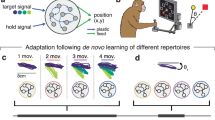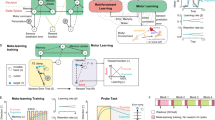Abstract
Humans (and robots) interacting with the environment have to deal with a continuous stream of sensory inputs in an incremental fashion. Such systems face two fundamental issues: (1) they must acquire new skills in a cumulative fashion, that is exploiting previous knowledge to learn new behaviors, and (2) they must avoid the so-called catastrophic interference, where learning new knowledge destroys existing memories. Here, we analyze the problem from the perspective of biological motor control. We first review experimental results of consolidation of procedural memories and the factors affecting it. Then the problem of generalization and interference is examined together with some interpretations in terms of computational models. Finally, we present some possible approaches to the issue of learning multiple tasks while avoiding catastrophic interference in bio-inspired learning architectures.
Access this chapter
Tax calculation will be finalised at checkout
Purchases are for personal use only
Similar content being viewed by others
Notes
- 1.
The policies and the outcomes may be complex. For example, the outcomes may actually be sequences of elementary observations, while the policies may be made up of sequences of elementary actions.
- 2.
A set is countable if every element of the set can be associated with a natural number. An example of countable set is the set of natural numbers \(\mathbb{N} =\{ 0, 1, 2, 3,\ldots \}\). The set \(\mathbb{R}\) of real numbers is an example of uncountable set.
References
Atkeson, C., & Santamaria, J. (1997). A comparison of direct and model-based reinforcement learning. In Proceedings., 1997 IEEE international conference on robotics and automation, 1997 (vol. 4, pp. 3557–3564). New York: IEEE.
Barto, A., & Mahadevan, S. (2003). Recent advances in hierarchical reinforcement learning. Discrete Event Dynamic Systems, 13(4), 341–379.
Barto, A., Singh, S., Chentanez, N. (2004). Intrinsically motivated learning of hierarchical collections of skills. In Proceedings of the 3rd international conference on development and learning. ICDL. (pp. 112–119).
Battig, W. (1972). Intratask interference as a source of facilitation in transfer and retention. In R. F. Thompson & J. F. Voss (Eds.), Topics on Learning and Performance. New York: Academic Press. (pp. 131–159).
Berniker, M., & Kording, K. (2008). Estimating the sources of motor errors for adaptation and generalization. Nature Neuroscience, 11(12), 1454–1461.
Bertsekas, D. P., & Tsitsiklis, J. N. (1996). Neuro-dynamic programming. Belmont: Athena Scientific.
Bizzi, E., Accornero, N., Chapple, W., Hogan, N. (1984). Posture control and trajectory formation during arm movement. The Journal of Neuroscience, 4(11), 2738–2744.
Braun, D., Aertsen, A., Wolpert, D., Mehring, C. (2009). Motor task variation induces structural learning. Current Biology, 19(4), 352–357.
Braun, D., Waldert, S., Aertsen, A., Wolpert, D., Mehring, C., Gribble, P. (2010). Structure learning in a sensorimotor association task. PLoS ONE, 5(1), e8973.
Caithness, G., Osu, R., Bays, P., Chase, H., Klassen, J., Kawato, M., Wolpert, D., Flanagan, J. (2004). Failure to consolidate the consolidation theory of learning for sensorimotor adaptation tasks. Journal of Neuroscience, 24(40), 8662–8671.
Cheng, G., Hyon, S., Morimoto, J., Ude, A., Hale, J., Colvin, G., Scroggin, W., and Jacobsen, S. (2007). CB: a humanoid research platform for exploring neuroscience. Advanced Robotics, 21(10), 1097–1114.
Corkin, S. (1968). Acquisition of motor skill after bilateral medial temporal-lobe excision. Neuropsychologia, 6(3), 255–265.
Criscimagna-Hemminger, S., & Shadmehr, R. (2008). Consolidation patterns of human motor memory. Journal of Neuroscience, 28(39), 9610–9618.
d’Avella, A., Saltiel, P., Bizzi, E. (2003). Combinations of muscle synergies in the construction of a natural motor behavior. Nature Neuroscience, 6(3), 300.
Dayan, P., & Balleine, B. (2002). Reward, motivation, and reinforcement learning. Neuron, 36(2), 285–298.
DeGroot, M. H. (1970). Optimal statistical decisions. New York: Wiley.
Dimitrakakis, C. (2012). Sparse reward processes. Technical Report arXiv:1201.2555v1, EPFL.
Doya, K., Samejima, K., Katagiri, K., Kawato, M. (2002). Multiple model-based reinforcement learning. Neural computation, 14(6), 1347–1369.
Emadi Andani, M., Bahrami, F., Jabehdar Maralani, P., Ijspeert, A. (2009). MODEM: a multi-agent hierarchical structure to model the human motor control system. Biological Cybernetics, 101(5), 361–377.
Eysenck, H. (1965). A three-factor theory of reminiscence. British Journal of Psychology, 56(163–181), 50–130.
Feldman, A. (1966). Functional tuning of the nervous system with control of movement or maintenance of a steady posture. ii. controllable parameters of the muscle. Biophysics, 11(3), 565–578.
Ferguson, K., & Mahadevan, S. (2006). Proto-transfer learning in markov decision processes using spectral methods. In Computer Science Department Faculty Publication Series (p. 151). Amherst: University of Massachusetts.
French, R. (1997). Pseudo-recurrent Connectionist Networks: An Approach to the “Sensitivity-Stability” Dilemma. Connection Science, 9(4), 353–380.
French, R. (1999). Catastrophic forgetting in connectionist networks. Trends in Cognitive Sciences, 3(4), 128–135.
Gomi, H., & Kawato, M. (1993). Recognition of manipulated objects by motor learning with modular architecture networks. Neural Networks, 6(4), 485–497.
Gomi, H., & Kawato, M. (1996). Equilibrium-point control hypothesis examined by measured arm stiffness during multijoint movement. Science, 272, 117–120.
Haruno, M., Wolpert, D., Kawato, M. (2001). Mosaic model for sensorimotor learning and control. Neural Computation, 13(10), 2201–2220.
Haruno, M., Wolpert, D., Kawato, M. (2003). Hierarchical mosaic for movement generation. In International Congress Series (vol. 1250, pp. 575–590). Amsterdam: Elsevier.
Hinton, G., & Plaut, D. (1987). Using fast weights to deblur old memories. In Program of the ninth annual conference of the cognitive science society (pp. 177–186). London: Lawrence Erlbaum.
Hogan, N. (1984). An organizing principle for a class of voluntary movements. The Journal of Neuroscience, 4(11), 2745–2754.
Huang, V., & Shadmehr, R. (2009). Persistence of motor memories reflects statistics of the learning event. Journal of Neurophysiology, 102(2), 931–940.
Jacobs, R., Jordan, M., Nowlan, S., Hinton, G. (1991). Adaptive mixtures of local experts. Neural Computation, 3(1), 79–87.
Kantak, S., Sullivan, K., Fisher, B., Knowlton, B., Winstein, C. (2010). Neural substrates of motor memory consolidation depend on practice structure. Nature Neuroscience, 13(8), 923–925.
Kawato, M. (1999). Internal models for motor control and trajectory planning. Current Opinion in Neurobiology, 9(6), 718–727.
Keisler, A., & Shadmehr, R. (2010). A shared resource between declarative memory and motor memory. The Journal of Neuroscience, 30(44), 14817–14823.
Kording, K., Tenenbaum, J., Shadmehr, R. (2007). The dynamics of memory as a consequence of optimal adaptation to a changing body. Nature Neuroscience, 10(6), 779–786.
Krakauer, J., Ghez, C., Ghilardi, M. (2005). Adaptation to visuomotor transformations: consolidation, interference, and forgetting. Journal of Neuroscience, 25(2), 473–478.
Krakauer, J., Mazzoni, P., Ghazizadeh, A., Ravindran, R., Shadmehr, R. (2006). Generalization of motor learning depends on the history of prior action. PLoS Biology, 4(10), e316.
Lindley, D. V. (1956). On a measure of the information provided by an experiment. Annals of Mathematical Statistics, 27(4), 986–105.
Lonini, L., Dipietro, L., Zollo, L., Guglielmelli, E., Krebs, H. (2009). An internal model for acquisition and retention of motor learning during arm reaching. Neural Computation, 21(7), 2009–2027.
Mahadevan, S., & Maggioni, M. (2007). Proto-value functions: a Laplacian framework for learning representation and control in Markov decision processes. Journal of Machine Learning Research, 8, 2169–2231.
Mandelblat-Cerf, Y., Novick, I., Paz, R., Link, Y., Freeman, S., Vaadia, E. (2011). The neuronal basis of long-term sensorimotor learning. The Journal of Neuroscience, 31(1), 300–313.
Medina, J., Garcia, K., Mauk, M. (2001). A mechanism for savings in the cerebellum. Journal of Neuroscience, 21(11), 4081–4089.
Mitchell, C., Nash, S., Hall, G. (2008). The intermixed-blocked effect in human perceptual learning is not the consequence of trial spacing. Journal Of Experimental Psychology, Learning, Memory and Cognition, 34(1), 237.
Mussa-Ivaldi, F., Giszter, S., Bizzi, E. (1994). Linear combinations of primitives in vertebrate motor control. Proceedings of the National Academy of Sciences, 91(16), 7534.
Norman, K., & O’Reilly, R. (2003). Modeling hippocampal and neocortical contributions to recognition memory: A complementary-learning-systems approach. Psychological Review, 110(4), 611–646.
Osu, R., Hirai, S., Yoshioka, T., Kawato, M. (2004). Random presentation enables subjects to adapt to two opposing forces on the hand. Nature Neuroscience, 7(2), 111–112.
Overduin, S., Richardson, A., Lane, C., Bizzi, E., Press, D. (2006). Intermittent practice facilitates stable motor memories. Journal of Neuroscience, 26(46), 1188–1892.
Pekny, S., Criscimagna-Hemminger, S., Shadmehr, R. (2011). Protection and expression of human motor memories. The Journal of Neuroscience, 31(39), 13829–13839.
Poggio, T., & Bizzi, E. (2004). Generalization in vision and motor control. Nature, 431(7010), 768–774.
Puterman, M. (1994). Markov decision processes: discrete stochastic dynamic programming. New York: Wiley.
Robertson, E. (2007). The serial reaction time task: implicit motor skill learning? Journal of Neuroscience, 27(38), 10073.
Robertson, E., Pascual-Leone, A., Miall, R. (2004a). Current concepts in procedural consolidation. Nature Reviews Neuroscience, 5(7), 576–582.
Robertson, E., Pascual-Leone, A., Press, D. (2004b). Awareness modifies the skill-learning benefits of sleep. Current Biology, 14(3), 208–212.
Rucci, M., Edelman, G., Wray, J. (1999). Adaptation of orienting behavior: from the barn owl to a robotic system. IEEE Transactions on Robotics and Automation, 15(1), 96–110.
Schmidhuber, J. (1991). A possibility for implementing curiosity and boredom in model-building neural controllers. In From animals to animats: proceedings of the first international conference on simulation of adaptive behavior (SAB90). Citeseer.
Scoville, W., & Milner, B. (1957). Loss of recent memory after bilateral hippocampal lesions. Journal of Neurology, Neurosurgery & Psychiatry, 20(1), 11–21.
Shadmehr, R., Smith, M., Krakauer, J. (2010). Error correction, sensory prediction, and adaptation in motor control. Annual Review of Neuroscience, 33, 89–108.
Shea, J., & Morgan, R. (1979). Contextual interference effects on the acquisition, retention, and transfer of a motor skill. Journal of Experimental Psychology: Human Learning and Memory, 5(2), 179–187.
Singh, S., Lewis, R., Barto, A., Sorg, J. (2010). Intrinsically motivated reinforcement learning: an evolutionary perspective. IEEE Transactions on Autonomous Mental Development, 2(2), 70–82.
Smith, M., Ghazizadeh, A., Shadmehr, R. (2006). Interacting adaptive processes with different timescales underlie short-term motor learning. PLoS Biology, 4(6), e179.
Spencer, R., Sunm, M., Ivry, R. (2006). Sleep-dependent consolidation of contextual learning. Current Biology, 16(10), 1001–1005.
Sutton, R., Precup, D., Singh, S. (1999). Between mdps and semi-mdps: a framework for temporal abstraction in reinforcement learning. Artificial Intelligence, 112(1), 181–211.
Sutton, R. S., & Barto, A. G. (1998). Reinforcement learning: an introduction. Cambridge: Cambridge University Press.
Taylor, M., & Stone, P. (2009). Transfer learning for reinforcement learning domains: a survey. The Journal of Machine Learning Research, 10, 1633–1685.
Thoroughman, K., & Shadmehr, R. (2000). Learning of action through adaptive combination of motor primitives. Nature, 407(6805), 742.
Valero-Cuevas, F., Venkadesan, M., Todorov, E. (2009). Structured variability of muscle activations supports the minimal intervention principle of motor control. Journal of Neurophysiology, 102(1), 59.
Vijayakumar, S., D’souza, A., Schaal, S. (2005). Incremental online learning in high dimensions. Neural Computation, 17(12), 2602–2634.
Walker, M., Brakefield, T., Hobson, J., Stickgold, R. (2003). Dissociable stages of human memory consolidation and reconsolidation. Nature, 425(6958), 616–620.
Wei, K., & Kording, K. (2009). Relevance of error: what drives motor adaptation? Journal of Neurophysiology, 101(2), 655.
Westermann, G., & Mareschal, D. (2008). A dual-memory model of categorization in infancy. In From associations to rules: connectionist models of behavior and cognition: proceedings of the tenth Neural Computation and Psychology Workshop, Dijon, France, 12–14 April 2007 (vol. 17, p. 127). Singapore: World Scientific Pub Co Inc.
Wolpert, D., & Kawato, M. (1998). Multiple paired forward and inverse models for motor control. Neural Networks, 11(7–8), 1317–1329.
Yamashita, Y., & Tani, J. (2008). Emergence of functional hierarchy in a multiple timescale neural network model: a humanoid robot experiment. PLoS Computational Biology, 4(11), e1000220.
Author information
Authors and Affiliations
Corresponding author
Editor information
Editors and Affiliations
Rights and permissions
Copyright information
© 2013 Springer-Verlag Berlin Heidelberg
About this chapter
Cite this chapter
Lonini, L., Dimitrakakis, C., Rothkopf, C., Triesch, J. (2013). Generalization and Interference in Human Motor Control. In: Baldassarre, G., Mirolli, M. (eds) Computational and Robotic Models of the Hierarchical Organization of Behavior. Springer, Berlin, Heidelberg. https://doi.org/10.1007/978-3-642-39875-9_8
Download citation
DOI: https://doi.org/10.1007/978-3-642-39875-9_8
Published:
Publisher Name: Springer, Berlin, Heidelberg
Print ISBN: 978-3-642-39874-2
Online ISBN: 978-3-642-39875-9
eBook Packages: Computer ScienceComputer Science (R0)




